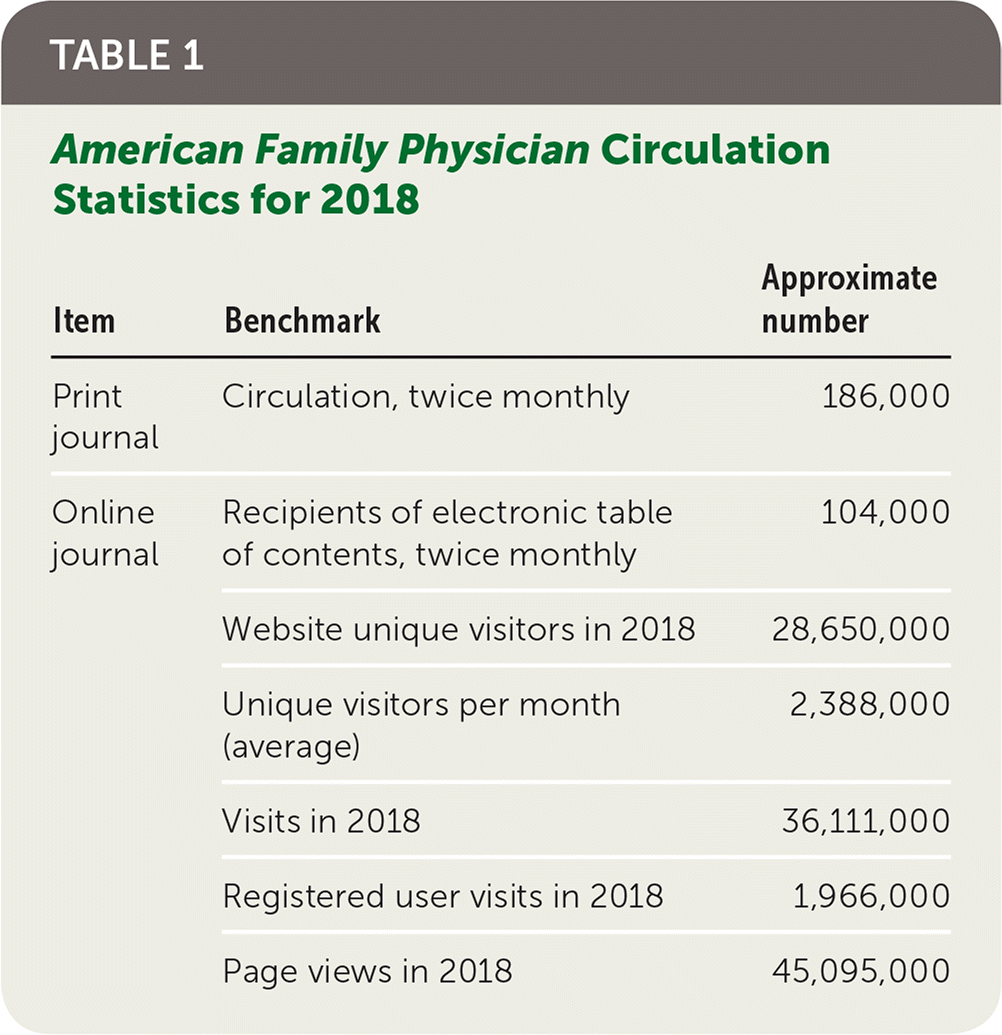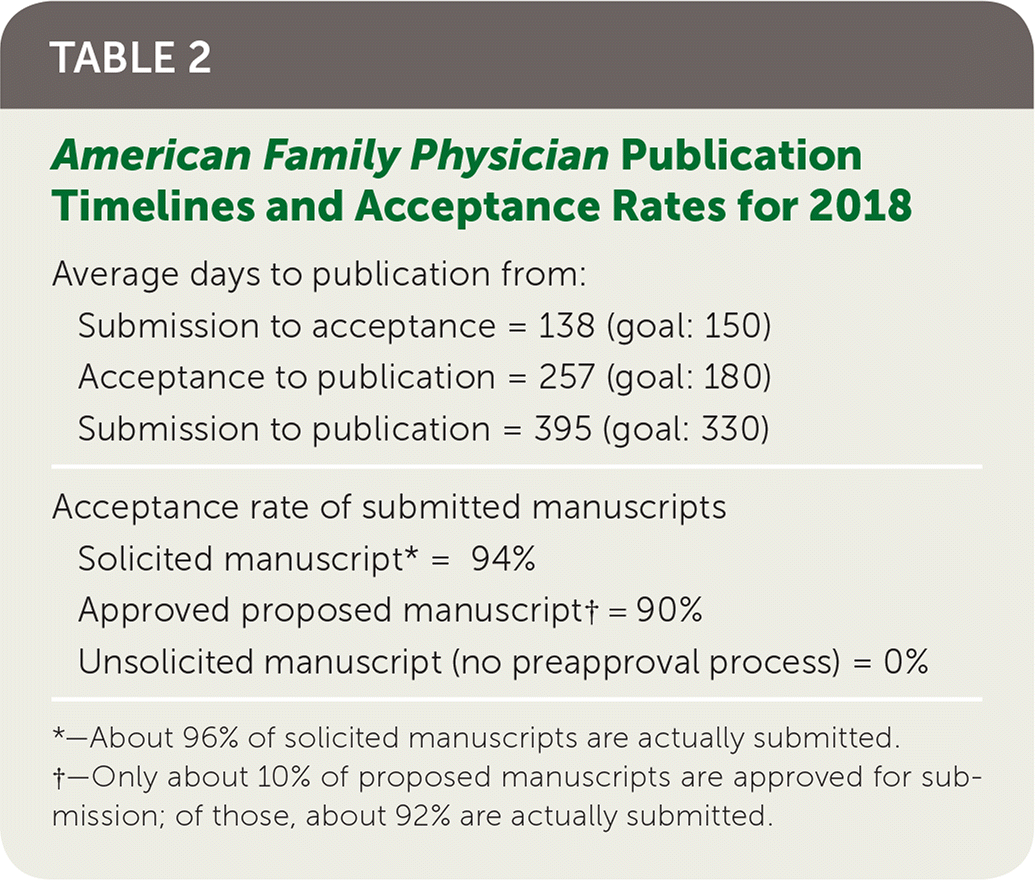
Am Fam Physician. 2019;99(9):538-540
Author disclosure: No relevant financial affiliations.
After having one year as editor-in-chief under my belt, I can say it has been an exciting challenge and a year of professional and personal growth. The purpose of this editorial is to welcome the first Jay Siwek medical editing fellow, share new journal features, highlight the top 20 American Family Physician (AFP) articles of 2018, provide an update on AFP’s statistics for print circulation and website visits, and thank AFP peer reviewers.1,2
Inaugural Jay Siwek Medical Editing Fellowship
The AFP team is fortunate to have had so many outstanding candidates apply for this new fellowship. It speaks to the talent among those who pursue a career in family medicine. We are proud to welcome Dr. Michael J. Arnold as the first Jay Siwek medical editing fellow. He currently serves as an assistant professor at the Uniformed Services University of the Health Sciences, and interestingly, has a background in electrical engineering and served as an undersea medical officer in the U.S. Navy. You can read more about his background and interests in the AFP Community Blog (https://afpjournal.blogspot.com/2019/04/introducing-dr-mike-arnold-first-jay.html).
New Content Features
In April of 2018, we published the first Rapid Evidence Review article (https://www.aafp.org/afp/2018/0415/p523.html) on osteoarthritis, a new feature developed by Dr. Mark Ebell, AFP deputy editor for evidence-based medicine.3 We plan to continue publishing traditional review articles, but this new format provides concise evidence-based content for those looking for a quick read. Stay tuned for more of these types of articles.
In November of 2018, we published the first Lown Right Care: Reducing Overuse and Underuse (https://www.aafp.org/afp/2018/1115/p560.html).4,5 The goal of this series, conceived under the guidance of Dr. Jay Siwek, AFP editor emeritus, and managed by Dr. Kenny Lin, AFP deputy editor, is to collaborate with the Lown Institute to summarize clinical practices that incorporate evidence-based interventions while avoiding unnecessary interventions—in other words, “getting care right.”
Most recently, we launched AFP Clinical Answers (http://www.aafp.org/afp/answers).6 This new series highlights important take-home points from past AFP issues to help readers quickly answer clinical questions.
Be on the lookout for another new series called Diagnostic Tests: What Physicians Need to Know, which will provide objective assessments of new tests similar to the way the STEPS: New Drug Reviews series evaluates drugs.
AFP’s Top 20 Articles of 2018
Don’t miss the top 20 AFP articles that were viewed the most by readers on the website in 2018 (https://www.aafp.org/journals/afp/explore/top-20-of-2018.html). Topics included outpatient insulin management in type 2 diabetes mellitus, acute migraines, vitamin D screening, well-child visits, transgender care, geriatric assessment, and several musculoskeletal themes such as low back pain, knee pain, and running injuries. Our goal is to highlight all of these topics in the new AFP Clinical Answers department. The top 20 most viewed AFP articles from 2017 can be found at https://www.aafp.org/journals/afp/explore/top-20-of-2017.html.
A collection of the top 20 research studies for primary care physicians, including an article on studies from 2018 that is published in this issue (https://www.aafp.org/afp/2019/0501/p565.html) and the top 20 POEMS consistent with the principles of the Choosing Wisely Campaign, can be found at https://www.aafp.org/afp/toppoems.
How to Stay Current with AFP
Have you listened to the AFP Podcast (https://www.aafp.org/afppodcast)? The podcast has been produced in partnership with the University of Arizona College of Medicine Phoenix Family Medicine Residency program since 2015 under the direction of Dr. Steven Brown, AFP contributing editor. More than 30,000 listeners tune in to each episode to hear clinical insights. The episodes have been downloaded more than 2,650,000 times (about 150,000 times per month) and the podcast was awarded the 2018 Innovative Program Award by the Society of Teachers of Family Medicine and also has received top honors from Association Media & Publishing.
You can read the top 10 AFP Community Blog posts of 2018 to learn about prostate-specific antigen screening, acute flaccid myelitis, the Choosing Wisely campaign, hypertension, travel tips, and more (http://afpjournal.blogspot.com/2018/12/the-top-ten-afp-community-blog-posts-of.html). The AFP Community Blog has had more than 660,000 page views since it launched in 2010 and is managed by Dr. Kenny Lin, with many insightful posts from Dr. Jennifer Middleton, AFP contributing editor.
Get a daily dose of useful tips from AFP’s Twitter feed (https://twitter.com/AFPJournal), which has nearly 11,000 followers, and AFP’s Facebook page (https://www.facebook.com/AFPJournal/), with more than 14,000 followers.
Stay current with evidence-based medicine (EBM) terminology using AFP’s Evidence-based Medicine Toolkit (https://www.aafp.org/journals/afp/authors/ebm-toolkit.html). The toolkit includes an EBM glossary, a list of EBM feature articles and departments, a description of Strength of Recommendation Taxonomy (the AFP evidence-rating system), background articles, and resources on EBM.
The AFP team is also in the process of building up the AFP video collection (https://www.aafp.org/journals/afp/explore/video.html) and AFP’s YouTube channel (https://www.youtube.com/user/AFPJournal) with more than 1,000 subscribers. If you are interested in submitting a video, please contact Dr. Chris Bunt, AFP contributing editor, at afpvideos@aafp.org.
Circulation and Website Statistics
The circulation of AFP’s print journal is approximately 186,000 (Table 1). To the best of our knowledge, this makes AFP the second-highest ranked among more than 5,000 peer-reviewed medical journals.7 Circulation includes 94,000 members of the American Academy of Family Physicians (AAFP), approximately 42,000 nonmember family physicians, and approximately 50,000 general internists. AFP has consistently been rated the number one journal among primary care physicians.8

| Item | Benchmark | Approximate number |
|---|---|---|
| Print journal | Circulation, twice monthly | 186,000 |
| Online journal | Recipients of electronic table of contents, twice monthly | 104,000 |
| Website unique visitors in 2018 | 28,650,000 | |
| Unique visitors per month (average) | 2,388,000 | |
| Visits in 2018 | 36,111,000 | |
| Registered user visits in 2018 | 1,966,000 | |
| Page views in 2018 | 45,095,000 |
The AFP website received more than 28 million unique visitors (attributable to a unique browser or device) in 2018, making it one of the most popular online medical publications. This means that in addition to visits by almost all AAFP members, the website is viewed by millions of other health care professionals and others who presumably are seeking information about various clinical conditions. Additionally, more than 450,000 continuing medical education (CME) credits were awarded to AFP readers in 2018.
Publication Timelines and Acceptance Rates
On average, review articles are accepted five months after they are submitted, which allows time for peer review and medical editing (Table 2). Articles are typically published eight to nine months after acceptance. A lot goes into the selection of articles for each issue to provide readers with a mix of topics.

| Average days to publication from: Submission to acceptance = 138 (goal: 150) Acceptance to publication = 257 (goal: 180) Submission to publication = 395 (goal: 330) |
| Acceptance rate of submitted manuscripts Solicited manuscript* = 94% Approved proposed manuscript† = 90% Unsolicited manuscript (no preapproval process) = 0% |
To ensure comprehensive coverage of a curriculum of topics, we solicit most of the articles that are published. Authors who propose topics go through a formal approval process before submitting a manuscript for consideration, and they are strongly encouraged to read the AFP Authors’ Guide before contacting us (https://www.aafp.org/afp/authors). Only about 10% of proposed topics are approved, often because the topic has already been covered or does not fit the AFP curriculum. For solicited and proposed topics, AFP editors provide authors with detailed guidance on the focus of the article. For these reasons, the acceptance rate for solicited manuscripts and approved proposals is high at 92%.
Acknowledging Peer Reviewers
Peer review continues to be an essential and valuable process for the journal, and we are highly appreciative of the work reviewers do in helping us develop sound content for AFP.9,10 In addition to recognizing peer reviewers for volunteering their time (https://www.aafp.org/journals/afp/reviewers/lists/2018.html), we are also highlighting reviewers who provided exceptional feedback and received a high rating on the reviews they provided to AFP authors and editors. An archive of past AFP peer reviewers is available at https://www.aafp.org/journals/afp/reviewers/lists.html. My hope is to continually improve our processes, enrich the skills of our current and future reviewers, and highlight more exceptional reviewers year after year.
Not only is peer review critical to producing good content, but it is also an important part of learning how to analyze articles and improving one’s own authorship skills. If you are interested in reviewing for AFP, please visit the Reviewers’ Guide (https://www.aafp.org/journals/afp/reviewers/guide.html) and complete a reviewer profile, or e-mail us at afpjournal@aafp.org. For new reviewers, we highly recommend that you find a mentor for your first review.
The AAFP has authorized CME credit for AAFP members who peer review manuscripts for journals. To report peer review CME activity, visit the AAFP’s Report CME Activities page (https://nf.aafp.org/Cme/Reporting/ClaimCredit.aspx) and select Scholarly Activity under the Report Self-Directed Learning Activities heading.
Finally, we want to give countless thanks to our dedicated authors and readers. We are proud of the reach and popularity of AFP and always welcome your feedback (afpjournal@aafp.org).
Editor’s Note: Dr. Sexton is Editor-in-Chief of American Family Physician.
